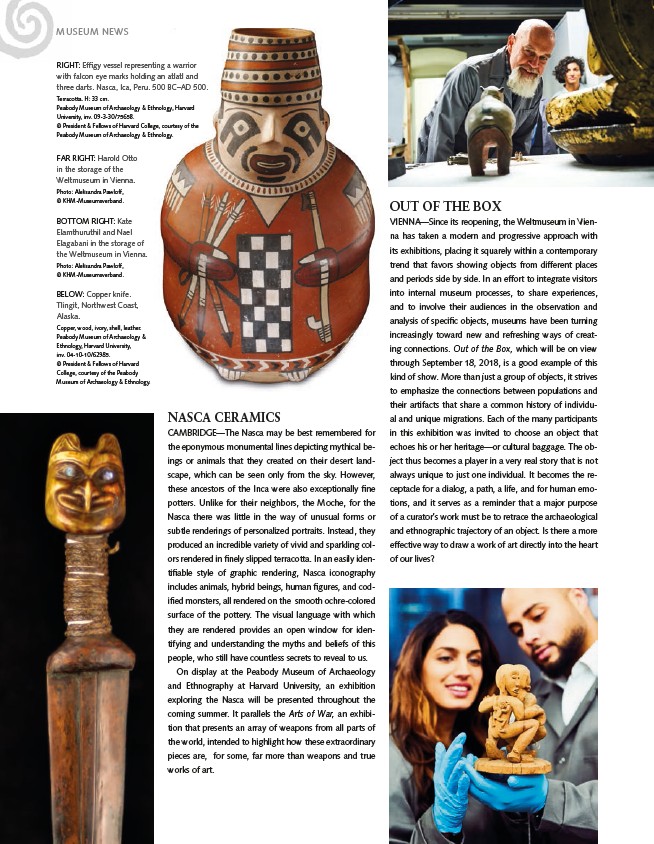
MUSEUM NEWS
RIGHT: Effi gy vessel representing a warrior
with falcon eye marks holding an atlatl and
three darts. Nasca, Ica, Peru. 500 BC–AD 500.
Terracotta. H: 33 cm.
Peabody Museum of Archaeology & Ethnology, Harvard
University, inv. 09-3-30/75658.
© President & Fellows of Harvard College, courtesy of the
Peabody Museum of Archaeology & Ethnology.
34
OUT OF THE BOX
VIENNA—Since its reopening, the Weltmuseum in Vienna
has taken a modern and progressive approach with
its exhibitions, placing it squarely within a contemporary
trend that favors showing objects from different places
and periods side by side. In an effort to integrate visitors
into internal museum processes, to share experiences,
and to involve their audiences in the observation and
analysis of specifi c objects, museums have been turning
increasingly toward new and refreshing ways of creating
connections. Out of the Box, which will be on view
through September 18, 2018, is a good example of this
kind of show. More than just a group of objects, it strives
to emphasize the connections between populations and
their artifacts that share a common history of individual
and unique migrations. Each of the many participants
in this exhibition was invited to choose an object that
echoes his or her heritage—or cultural baggage. The object
thus becomes a player in a very real story that is not
always unique to just one individual. It becomes the receptacle
for a dialog, a path, a life, and for human emotions,
and it serves as a reminder that a major purpose
of a curator’s work must be to retrace the archaeological
and ethnographic trajectory of an object. Is there a more
effective way to draw a work of art directly into the heart
of our lives?
NASCA CERAMICS
CAMBRIDGE—The Nasca may be best remembered for
the eponymous monumental lines depicting mythical beings
or animals that they created on their desert landscape,
which can be seen only from the sky. However,
these ancestors of the Inca were also exceptionally fi ne
potters. Unlike for their neighbors, the Moche, for the
Nasca there was little in the way of unusual forms or
subtle renderings of personalized portraits. Instead, they
produced an incredible variety of vivid and sparkling colors
rendered in fi nely slipped terracotta. In an easily identifi
able style of graphic rendering, Nasca iconography
includes animals, hybrid beings, human fi gures, and codifi
ed monsters, all rendered on the smooth ochre-colored
surface of the pottery. The visual language with which
they are rendered provides an open window for identifying
and understanding the myths and beliefs of this
people, who still have countless secrets to reveal to us.
On display at the Peabody Museum of Archaeology
and Ethnography at Harvard University, an exhibition
exploring the Nasca will be presented throughout the
coming summer. It parallels the Arts of War, an exhibition
that presents an array of weapons from all parts of
the world, intended to highlight how these extraordinary
pieces are, for some, far more than weapons and true
works of art.
FAR RIGHT: Harold Otto
in the storage of the
Weltmuseum in Vienna.
Photo: Aleksandra Pawloff,
© KHM-Museumsverband.
BOTTOM RIGHT: Kate
Elamthuruthil and Nael
Elagabani in the storage of
the Weltmuseum in Vienna.
Photo: Aleksandra Pawloff,
© KHM-Museumsverband.
BELOW: Copper knife.
Tlingit, Northwest Coast,
Alaska.
Copper, wood, ivory, shell, leather.
Peabody Museum of Archaeology &
Ethnology, Harvard University,
inv. 04-10-10/62985.
© President & Fellows of Harvard
College, courtesy of the Peabody
Museum of Archaeology & Ethnology.